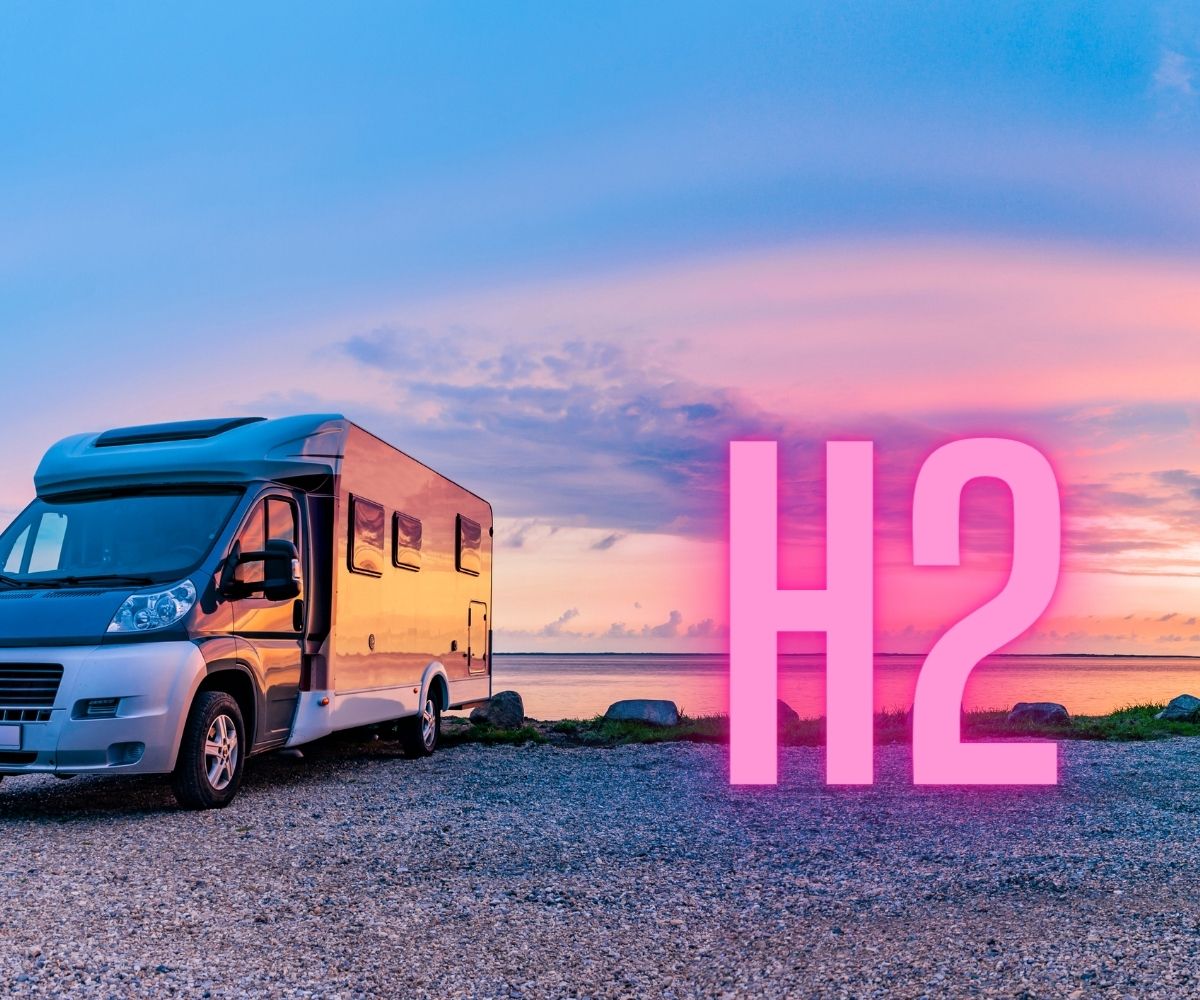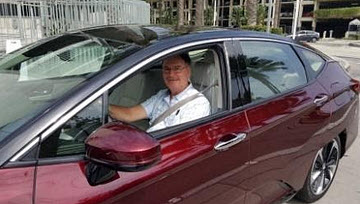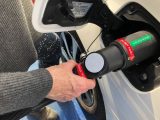
Revolutionize Your Camping Experience: What About a Hydrogen Powered RV?
September 15, 2021Let’s nudge folks toward cool, refreshing hydrogen powered RVs!
Thaler and Sunstein in their book Nudge, The Final Edition, suggest: “If the goal is to make the environment cleaner, a simple idea is to make the green option the easy option”. My takeaway: When encouraging folks to choose a zero-CO2 vehicle, the recommended choice should simply be better than the alternatives.
My first two Hydrogen Fuel News articles recommend that Ford should change course immediately to hit this goal. The driving range of its new battery-electric Lightning pickup will be anemic, especially when towing a trailer. Ford should convert it to hydrogen-electric and support it with a country-wide “starter network” of fuel stations. Those stations would produce their own hydrogen on the spot, from solar electricity and water – no tanker trucks or pipelines need apply.
A hydrogen-powered “LightningH” will have a thousand-mile range using its 580 kWh of stored energy — 500 miles even when towing a travel trailer.
The result will be a truck that can do its job better than any other choice. The only Nudge required will be built-in: word of mouth from owners enthused about its superior power, range and whisper-quietness. It’s easy to imagine 50 million clean and green H-trucks on the road by 2035, given the 60 million fossil-fueled pickups out there now (with ten-year average lifespans). The LightningH (and H-trucks from other manufacturers) should own the market well before 2030.
But wait, there’s more! 😉
About ten million of us own RV’s, happily navigating them through the North American vistas. Trailers and motorhomes must also have zero-CO2 propulsion within a decade or so. What if we follow the “Nudge Rule” and develop RVs that are better in every way than the current models?
We can! Let’s have a little fun with the LightningH chassis:
I pull a 20’ travel trailer with our gasoline-powered F150. I’d prefer to pull it with a LightningH, but we’ll have to wait a bit for that 😉. A lot of folks would rather drive their RV than pull it, so a good alternative is a Class B (or a wider B+) camper van built on a chassis from Ford, GM, Chrysler or Mercedes. The best of these sport a comfortable bed, a usable bathroom, a compact kitchen that would be de rigueur in a NYC efficiency apartment, water and waste tanks, furnace and air conditioning – a complete tiny home that can transport us anywhere. Many have solar power and lithium batteries — they can spend days in far-away places, independent of external power and water.
But – they’re all limited by the same expendables. The builder fits tanks to store so-called “black water” (a euphemism we shall not discuss further), gray water from the sink/shower, and fresh water. With a little camper care, the first two tanks can handle quite a few days in the wild. But, for folks who appreciate the occasional hot shower after a hike, it’s an empty freshwater tank that ends the trip.
The other limiting resource is electricity. On a good day the batteries are refilled by Mother Sun — unless things heat up and we’d like to run the air conditioner. An A/C uses more energy than solar and lithium can provide for long, and a gasoline-powered generator won’t fit into a zero-carbon world.
What if we had a magical source of fresh water to refill the tank, and enough energy to run the A/C as long as we’d like? 
Recall that the LightningH chassis will produce pure water vapor as it combines hydrogen with oxygen in its silent fuel cell. Remember too that our camper stores plenty of hydrogen since it’s built on the LightningH chassis. Such a wondrous machine 😉 could operate its A/C for long periods, making fresh water as a bonus.
How long and how much? Let’s do a little math:
The LightningH design stores about 24 kg of hydrogen in its high-pressure tanks. (Creative folks seem likely to store more hydrogen at lower pressure soon [see poweringaplanet.com], but let’s go with what we know.) Let’s say we’re camped 100 miles from the nearest H-fuel station (see that second HFN article). We’ve set aside 8 kg of hydrogen to get to the campsite and back. Does that leave us enough to run the air conditioner? (Hint: 😊)
An RV A/C uses 1500 watts when running – but its compressor (the big energy draw) runs only about half the time when it’s 90 degrees outside. (If it’s going to be hotter than that, recall that your tiny home has wheels. Drive a day north or a few thousand feet up – don’t sweat it.) So – the A/C uses about a kWh per hour. How long will our 16 kg of H keep that chiller humming?
Two thirds (16/24) of our stored hydrogen’s 580 kWh capacity is 390 kWh. A LightningH Camper Van could operate its A/C for a comfortable 390 hours (!) and still have the reserves to return to civilization. Not bad! 😉
We’d have run out of fresh water by then, without the hydrogen system. How much water will our camper create while running that A/C?
Oh-oh – We need to do a little more math (and invoke a bit of my own history):
Recall that water is made from two H and one O atoms: it’s H2O. Oxygen is heavy – most of water’s mass is O and we’ll be extracting that from the atmosphere. (Our hydrogen was originally split from water using green electricity; the refueling station stored the H and released the O. When our Circle of H is complete, we’ve used up no oxygen, hydrogen or water and employed solar power to make it all happen. This is why I get so enthusiastic about this stuff 😊.)
When we combine our 16 kg of H with oxygen (an atom of which has a mass eight times that of water’s two H atoms), we create 144 kg (317 lbs) of H2O. At 8 lbs per gallon, we can condense up to 40 gallons from the fuel cell’s output into our freshwater tank. This while chilling ourselves plus refreshments waiting in the electric fridge. If we had 32 gallons in the tank when the trip began, our excursion will have up to 72 gallons of water available in total.
Note: A “Navy shower” needs about 3 gallons (get wet, faucet off, soap up, rinse). I spent several years taking Navy showers on our ship – long hot ones are better, but you come clean either way. 72 gallons is 24 Navy showers, but the RV’s kitchen and commode need some too, so figure half that. That’ll wash (sparingly) for a couple of weeks. The other two tanks (the gray water and that unmentionable one) will be full by then — it’s plenty!
This same math applies to any camper: a travel trailer pulled by a LightningH that uses energy and condenses water from the truck; a large “Class A” motorhome storing several times as much hydrogen, making lots of energy and water. They’ll all be much more capable on a hydrogen platform.
condenses water from the truck; a large “Class A” motorhome storing several times as much hydrogen, making lots of energy and water. They’ll all be much more capable on a hydrogen platform.
That extra electricity and water will be appreciated — a lot 😉! Buyers will choose HCampers simply because they’re more useful. It’s an effective Nudge toward a significant climate plus – the HCampers will be superior to any other RVs.
Sixty million hydrogen trucks and campers (plus a hundred million shorter-range battery-powered cars) will put a serious dent in our climate impact.
Spin the camper technology out to the rest of the world and we’ve done a lot of good, at no cost — we’ll be buying the new vehicles anyway, and people will prefer to buy these machines. We will be Nudged toward virtue.
In future articles, we’ll examine how we might talk the U.S. energy system into being both zero-CO2 and reliable. Those two requirements don’t play well together. You may have noticed that some experts jump nimbly past discussing the day/night and seasonal energy storage required for a solar/wind-powered system as enormous as the entire U.S. That’s because it’s difficult to imagine how to do it.
We’ll give it a try. It may involve Nudging.
-Bob

The author, Dr. H. Robert Meyer, seen here driving a hydrogen-powered demo at a SEPA energy conference, is an environmental scientist with decades of experience. After serving as a Navy Officer he began his career at the Oak Ridge National Laboratory then moved on to run large projects around the country. His background in physics, environmental protection and alternative energy helps unravel the complexities of converting a planet to all-electric. His website at https://poweringaplanet.com is focused on the tough-to-grasp size of the CO2 reduction problem — the effort required to reverse climate change is not yet widely understood. We need to drastically ramp up the installation rates of green energy and its backups to get to zero emissions before time runs out.



 HFN News is your leading source for fresh hydrogen and renewable energy updates. Amid the fast-paced growth of hydrogen companies, we provide top-notch news and insights about this exciting sector. Our coverage spans from hydrogen cars to global sustainable initiatives, and we highlight the latest in green jobs and developing hydrogen hubs. We invite you to share your local hydrogen news and explore today’s renewable energy job listings on our site. Thanks for choosing HFN News as your trusted guide to the hydrogen and renewable energy world!
HFN News is your leading source for fresh hydrogen and renewable energy updates. Amid the fast-paced growth of hydrogen companies, we provide top-notch news and insights about this exciting sector. Our coverage spans from hydrogen cars to global sustainable initiatives, and we highlight the latest in green jobs and developing hydrogen hubs. We invite you to share your local hydrogen news and explore today’s renewable energy job listings on our site. Thanks for choosing HFN News as your trusted guide to the hydrogen and renewable energy world!